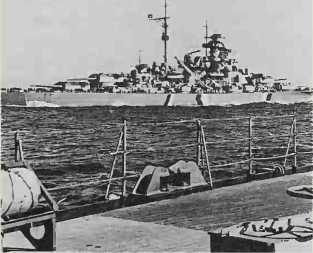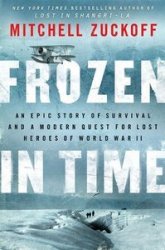Bismarck. German battleship, eight 15in guns and among the most heavily armoured ships of her day.
On May 21 1941, Bismarck, sailing in company with the cruiser Prinz Eugen, emerged from the Baltic and shaped to break out into the North Atlantic. The British c-in-c, Tovey, on King George V, accompanied by Victorious and joined by Repulse sailed with cruiser and destroyer support to block the break-out. On the evening of May 23, one of his scouting cruisers, Norfolk, spotted the German ships on course for the Denmark Strait. Prince of Wales and Hood altered course to intercept. In a brief action on the 24th, Hood

Battleship Bismarc/j, sunk May 1941
Was blown up and Prince of Wales damaged. Bismarck lost about
1,000 tons of fuel, which reduced her range decisively, and heading for the French coast, got south of Tovey’s main units. Meanwhile, however. Force H {Renown, Ark Royal and Sheffield) had been called up from the south. On May 26, air patrols spotted Bismarck and on that evening she was attacked by Swordfish from Ark Royal. One of their torpedoes hit her rudders. Tovey was, therefore, able to come up in King George V with Rodney in company and, on May 27, they dispatched Bismarck with the final assistance of torpedoes from Dorsetshire. ANF.
Bismarck Sea, Battle of the,
(March 2-5 1943). On March 1, a Japanese convoy of eight transports escorted by eight destroyers, carrying c7,000 troops from Rabaul to reinforce the garrisons of northeast New Guinea, was sighted by a B-24 Liberator of Gen Kenney’s Fifth Air Force. On
March 2, one transport was sunk by B-17 Fl3dng Fortresses: destroyers rescued c850 men and delivered them to Lae, but these were the only troops to reach New Guinea. On March 3, in a series of attacks by B-17s, B-24s, B-25 Mitchells, A-20 Havocs and raaf Beauforts and Beaufighters, with strong fighter escort, six transports and four destroyers were sunk and 25 Japanese fighters shot down. The newly developed technique of low-level “skip bombing” by B-25s carrying 5001b bombs with five-second-delay fuses proved most effective. Japanese survivors in rafts or landing craft were mercilessly strafed. On March 4, usn PT-Boats joined the mopping-up, sinking the one remaining transport and machinegunning and depth-charging survivors. Some 3,000 Japanese died; c2,700 were rescued by the surviving destroyers and two submarines and returned to Rabaul. Only five Allied aircraft were lost. RO’N.
Bizerta. Captured by II US Corps (Bradley) on May 7 1943. See also
TUNISIAN CAMPAIGN.
Black and Tans see anglo-irish
WAR.
“Black Day of the German Army”, August 8 1918 (so described by Ludendorff). The day on which Haig broke through between Albert and Moreuil.
Blackett, Lord (1897-1974). Br. After naval service in World War I, Blackett became a leading physicist, playing an important part in the development of the radar chain. On the outbreak of war, he went to Anti-Aircraft Command where there was much scope for the application of scientific ideas to the somewhat crude methods of aiming then available. He then went to Coastal Command, where he introduced systems of operational research which were a substantial factor in transforming the force from its relative inefficiency at the beginning of the war to what became by the middle of 1943 a formidable weapon of sea power. Blackett’s political views sometimes clouded the objectivity of his assessments and, despite his own naval experience, his opinion was surprisingly theoretical. ANF.
Blackhawk, Sikorsky UH-60/S-
67. American combat support helicopter replacing the Iroquois.
Blackshirts. Italian fascist supporters whose violent activities helped Mussolini to power.
Blake, George (b. l923). Br. Spy, changed name from Behar; father Egyptian Jewish, mother Dutch Christian; brought up in Cairo by Jewish communist banker; brought out of occupied Holland by soe; joined Royal Navy, then Foreign Office; vice consul in Seoul, 1950, captured by communists; on release, 1953, joined MIG, having by then become converted to communism; spied for six years for KGB, especially in Berlin. Betrayed, confessed, sentenced to 42 years, 1959; escaped to Russia,
1965.
Blakeslee, Col Donald J M
(b. l918). US. Distinguished fighter leader with 15.5 victories in over
1,000 hours of combat flying. As commander of the US 4th Fighter Group in 1944 he helped to pioneer the tactics employed so successfully by P-51 Mustang units on long-range missions over Germany.
Blarney, Field Marshal Sir Thomas Albert (1884-1951). Australian. Distinguishing himself in the Gallipoli evacuation. Blarney ended World War I as a Brigadier; cos to Monash on the Western Front. In 1940 he became commander of the Australian army corps formed for Middle East service. Early in 1941, as Commander, Anzac Corps, he played a major part in planning the Allied evacuation from Greece, but his largely cosmetic appointment (as an Australian “token”) as Deputy c-in-c. Middle East, later that year, was marred by clashes with his superior, Auchinleck.




 World History
World History









